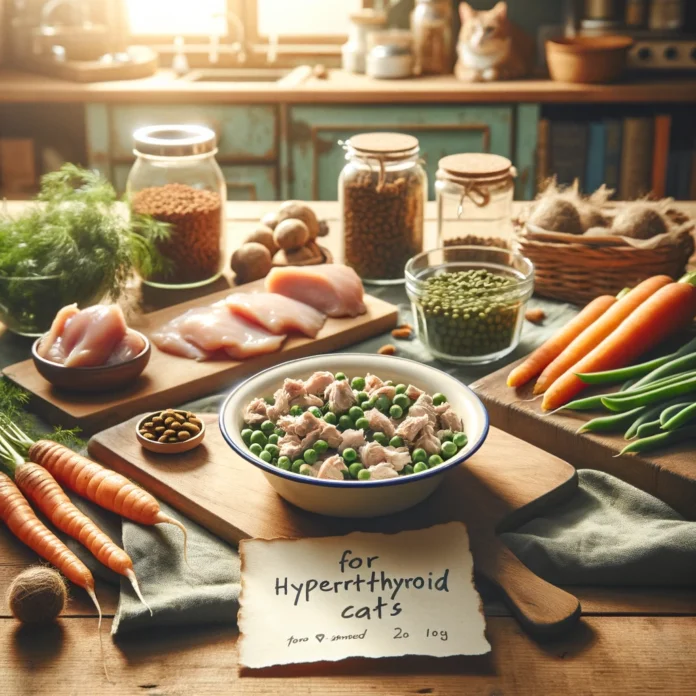Welcome, fellow cat devotees! Today, we embark on a culinary journey tailored specifically for our feline friends grappling with hyperthyroidism. It’s not just about filling their bowls; it’s about nourishing their spirits and boosting their health with every bite. If you’ve noticed your furball has turned into a bottomless pit of hunger yet is losing weight, you might be dealing with hyperthyroidism. Fear not! This will guide you through the whys, the whats, and the how-tos of crafting homemade meals that are not just vet-approved but also cat-applauded. Ready to transform your kitchen into a cat-friendly Michelin-starred restaurant? Let’s dive in!
Understanding Hyperthyroidism in Cats:
What’s Going On Inside?
Hyperthyroidism in cats is like a turbo engine that’s always on. It speeds up their metabolism, causing weight loss, increased appetite, and, sometimes, a cranky attitude. Here, we’ll break down the science into bite-sized, easily digestible pieces. Understanding this condition is the first step to becoming the chef your cat needs.
The Pillars of a Hyperthyroid-Friendly Diet:
Key Ingredients to Include and Avoid:
Creating the perfect menu for a cat with hyperthyroidism involves knowing what to add and leave out. This section will cover the must-haves, like iodine-controlled ingredients, and the no-gos, ensuring your cat’s meal is tasty and therapeutic.
Recipe Roundup: Chef’s Special for Hyperthyroid Cats:
Simple Yet Savory Dishes:
Here’s where we roll up our sleeves and get down to business. We’ll share recipes that outshine and outflavour those you’ve seen before, from delectable chicken feasts to tantalizing fish delights designed to cater to your cat’s health and palate. Plus, we’ll sprinkle in some pro tips to make these meals even more irresistible.
Supplementing the Homemade Diet:
Beyond the Bowl:
A meal plan is only complete with the right supplements. We’ll explore the vitamins and minerals crucial for supporting a hyperthyroid cat’s health, ensuring you’re feeding them and truly nourishing them.
Transitioning Your Cat to Homemade Meals:
The Art of Culinary Persuasion:
Cats are creatures of habit, and changing their diet can be akin to negotiating a peace treaty. This section will provide strategies for making the transition as smooth as a purr, ensuring your cat embraces their new dining experience with enthusiasm.
Safety First: Consulting with Your Vet:
The Importance of Professional Guidance:
While we’re all for embracing your inner chef, working closely with your vet is crucial. We’ll discuss keeping your vet in the loop and ensuring your homemade diet complements your cat’s medical treatment and supports their overall health.
Vet-Approved Homemade Cat Food Recipes
When it comes to feeding our feline friends, especially those with hyperthyroidism, the seal of approval from a vet is like gold. Vet-approved homemade cat food recipes ensure that you are providing meals tailored to your cat’s health condition and meeting their nutritional needs. These recipes balance protein, fats, and limited iodine levels to manage hyperthyroid symptoms. Ingredients like chicken, turkey, and non-iodine salt are staples. Remember, the goal is to maintain a balanced diet that supports your cat’s overall health while managing their condition. Incorporating a variety of vet-recommended recipes can help prevent mealtime monotony and ensure your cat enjoys their food as much as it benefits their health.
Easy, Cheap, Homemade Cat Food
Crafting homemade cat food can save your wallet and your time. Easy, cheap, homemade cat food recipes use simple, affordable ingredients without compromising nutrition. Think boiled chicken, rice, peas, or a blend of lean ground turkey with carrots. These ingredients are not only cost-effective but also easy to prepare. The key is to focus on protein-rich ingredients that provide the energy and nutrients your cat needs without unnecessary fillers or high iodine content. By preparing batches and storing them properly, you can save time and money, proving that feeding your cat a homemade diet can be economical and straightforward.
Non-Prescription Low Iodine Cat Food
Managing iodine intake is crucial for cats with hyperthyroidism, but it doesn’t mean you need to rely solely on expensive prescription diets. Non-prescription low-iodine cat food can be made at home with a careful selection of ingredients. The trick is to choose proteins and vegetables low in iodine, such as chicken, beef, carrots, and green beans. Avoiding seafood and iodized salt is vital to keeping the iodine levels in check. Creating a meal plan that includes various ingredients ensures your cat’s diet is balanced and supports their thyroid health without needing prescription food.
Low Iodine Cat Food for Hyperthyroidism
Low-iodine cat food is a cornerstone in managing hyperthyroidism in cats. This specialized diet helps regulate thyroid hormone production, alleviating symptoms and improving quality of life. Homemade versions can be just as effective as commercial ones, with the added benefit of customizing your cat’s taste preferences. Ingredients like non-iodized salt, egg whites, and specific cuts of meat can form the basis of these meals. It’s about crafting a diet that minimizes iodine intake while providing all the essential nutrients your cat needs. Consulting with your vet to tailor these recipes to your cat’s specific health profile is critical for success.
What is the Best Homemade Food for Cats
The best homemade food for cats balances nutritional needs and palatability. It should cater to its predatory nature, focusing on high-quality proteins, essential fatty acids, and minimal carbohydrates. A mix of cooked meats like chicken or turkey, vital organs for nutrients, and a small portion of vegetables for fibre makes for an ideal meal. This combination ensures that your cat gets a diet close to what they would naturally eat, with all the necessary vitamins and minerals. Incorporating a vet-recommended supplement can also help fill any nutritional gaps, making delicious and nutritious homemade meals.
Easy Homemade Cat Food
Easy homemade cat food is all about simplicity and nutrition. Recipes that require minimal ingredients and preparation time can still provide your cat with a balanced and healthy diet. Essential recipes include cooked, finely chopped meat mixed with a small amount of cooked vegetables and a calcium supplement to ensure bone health. The emphasis is on using fresh, quality ingredients to create meals that appeal to your cat and benefit their health. This approach to homemade cat food proves you can use simple recipes to feed your cat well.
Homemade Cat Food Supplement
Including a homemade cat food supplement is vital to ensure that your DIY cat meals are nutritionally complete. These supplements often contain essential nutrients that might not be sufficiently present in meat, such as taurine, vitamins E and B, and calcium. You can purchase a premade supplement designed for homemade cat food or create your mix under veterinary guidance. The key is to understand your cat’s specific needs, especially if they have health conditions like hyperthyroidism, to ensure the supplement complements their diet perfectly.
Homemade Wet Cat Food Recipes
Homemade, wet cat food recipes offer hydration and nutrition, making them an excellent choice for your cat’s diet. These recipes often involve a combination of cooked meats, such as chicken or fish, mixed with broth to ensure moisture content. Adding a small number of vegetables or rice can provide additional nutrients and fibre. The benefit of wet food is its appeal to cats, especially those who may not drink enough water, and its ability to be customized to individual health needs, including hyperthyroidism. Creating these meals at home allows you to control the quality and freshness of the ingredients, offering a healthy, hydrating option for your cat.
Conclusion:
Creating homemade meals for a cat with hyperthyroidism is more than just a dietary change; it’s an act of love. With the proper knowledge, ingredients, and a dash of creativity, you can offer your cat not just a meal but a better quality of life. Remember, the path to your cat’s health is through their stomach, and with these tips and recipes, you’re well-equipped to start this journey. Happy cooking, and here’s to the health and happiness of your feline royalty!

